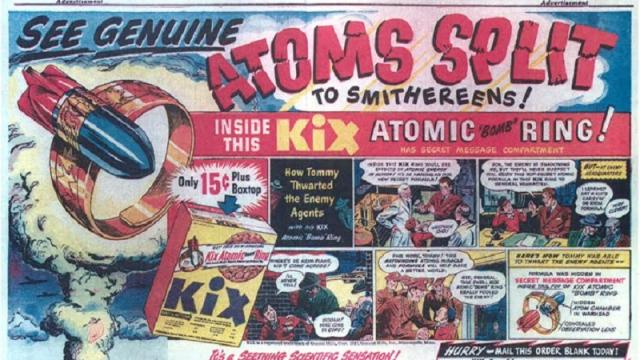A recent episode of QI mentioned a secret Lone Ranger Decoder Ring that contained plutonium and let kids see the flashes it gave off. While never appropriate for children, this toy has an impressive scientific pedigree.
The Lone Ranger Decoder Ring has graced this site before. It has also graced the hands of many children during the 1950s, given out as part of a cereal company’s promotional campaign. The ring came with a tiny bit of plutonium and a screen which lit up and allowed to “see” the plutonium emitting alpha particles.
Over in America, more than 750,000 kids got one. Author Michael Strauss recalls that he bought one of them from the General Mills cereal company for 15 cents and the box top from a box of KIX cereal. He writes, “I spent an hour each night in the dark of my room, looking at those mysterious flashes, trying to comprehend what they meant and how they happened.”Strauss broke open his ring and built a cloud chamber with which to watch the emissions from the plutonium, getting two scientific instruments for the price of one.
The ring has a history. It’s most famous for the the Rutherford Gold Foil Experiment, which first gave the world the idea of a solid, compact, atomic nucleus surrounded by electrons. Under the direction of Ernest Rutherford, scientists shot alpha particles at a thin film of gold foil and found that some of them, not most, but some, bounced off the gold foil. At the time it was described as the equivalent of shooting a cannonball at tissue paper and having the cannonball sometimes come right back at you. Rutherford, as well as Hans Geiger and Ernest Marsden, were able to see where the alpha particles ended up because they had a screen coated with zinc sulfide, just as the ring did. Zinc sulfide is phosphorescent, and will light up when excited by something, like the speeding clump of two protons and two neutrons which is an alpha particle.

But Rutherford’s team was conducting these experiments in 1908. The real origin of this ring comes from a guy who was careless with radium. Zinc sulfide was known to produce a glow when exposed to radioactive materials, a fact that was so interesting that some scientists just took a look for kicks. In 1903 Sir William Crookes, a chemist and physicist, was enjoying the warm and uniform glow of zinc sulfide lit up by radium when he spilled his radium. He used the screen to help him find his lost radioactive material, when he was astonished to find that, under a microscope, the warm glow was made up of lots of little flashes. Deciding that this could be useful, he worked the entire thing into a view apparatus. It was a tube coated on the inside with zinc sulfide, a central space for radioactive material, and a clear viewing screen. He called it the “spinthariscope.”
If only he had thought to make it into a decoder ring. He could have sold three quarters of a million of them.
